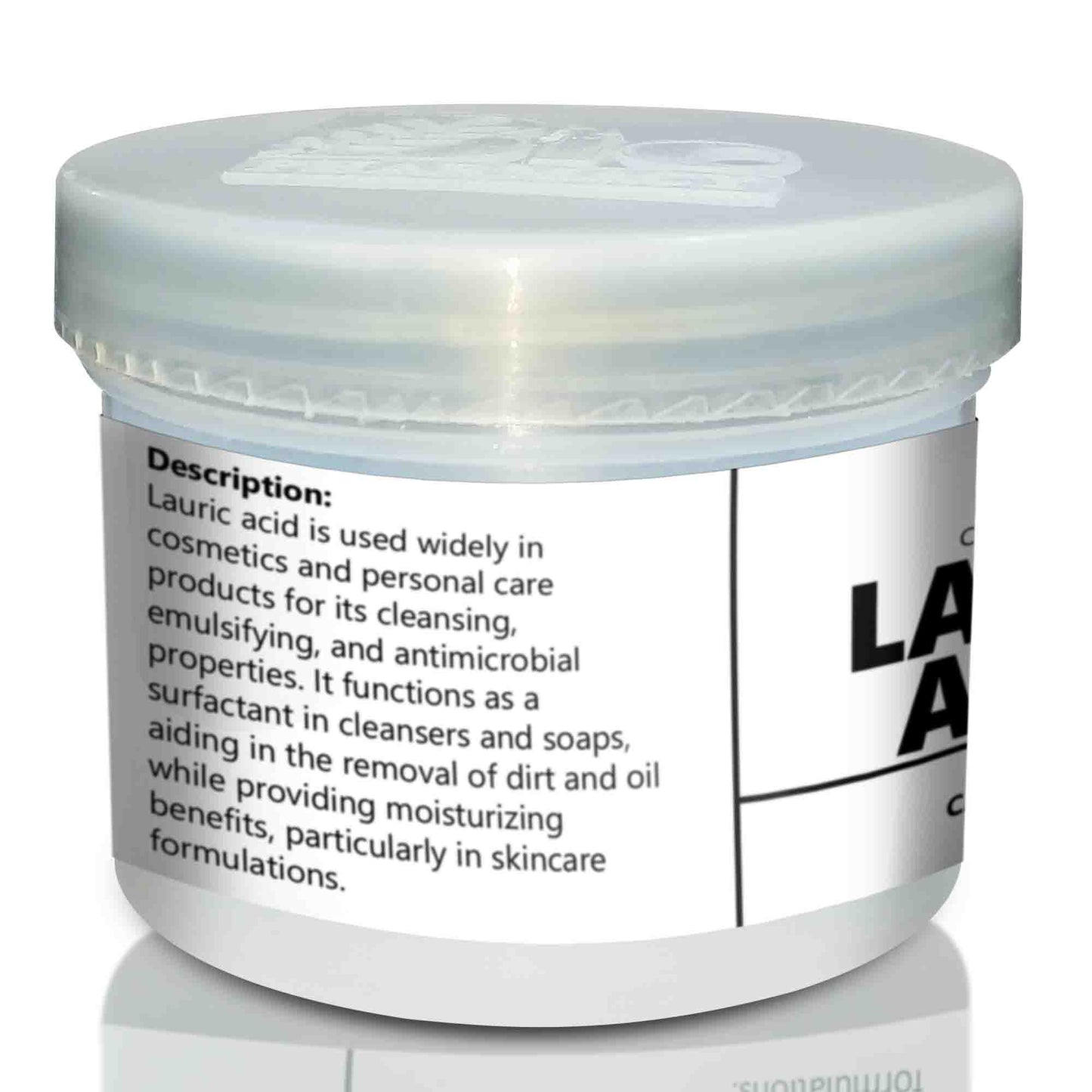Bio Shop
Lauric Acid
Lauric Acid
Key Functions: Acts as a foam booster, cleansing agent, and hardener in soaps and surfactant-based formulations.
Couldn't load pickup availability



Explore
Information About Lauric Acid
✅ Key Features
- Provides high, stable foam in soaps and shampoos
- Improves cleansing efficiency in face and body washes
- Hardens cold process soaps and adds creamy texture
- Derived from coconut oil, plant-based and vegan
- Acts as a co-emulsifier and texture enhancer in emulsions
🔬 Description
Lauric Acid – High-Foaming Fatty Acid for Soaps, Cleansers & Surfactants
Lauric Acid is a saturated medium-chain fatty acid (C12) extracted from coconut or palm kernel oil, widely used in personal care formulations. Known for its excellent foaming and cleansing abilities, Lauric Acid is a staple in cold process soap making, surfactant systems, and shaving foams. It helps increase lather, improve bar hardness, and add a silky, conditioning afterfeel to rinse-off products. In emulsions, it serves as a co-thickener and co-emulsifier, giving body and consistency.
📊 Technical Data
INCI Name: Lauric Acid
CAS Number: 143-07-7
Solubility: Oil-soluble
Add Phase: Oil phase (heated)
pH Stability: Stable across wide pH range
Processing Temperature: 60–75°C
Appearance: White powder or flakes
Odor: Mild fatty odor
Molecular Formula: C₁₂H₂₄O₂
Molecular Weight: 200.32 g/mol
Flash Point: > 150°C
Density: ~0.87 g/cm³
Chemical Type: Saturated fatty acid
Functional Groups: Carboxylic acid
Primary Cosmetic Uses: Soap making, shampoos, facial cleansers, shaving foams, emulsions
🧪 Recommended Usage
- Usage Rate: 1% – 20%
- Phase: Add in heated oil phase
- Ideal For: Bar Soaps, Face Wash, Shampoos, Cream Cleansers
💡 Pro Tip
🧼 For perfect soap bars, blend Lauric Acid with Stearic and Myristic Acids for hardness, cleansing, and luxurious foam. In surfactant cleansers, combine with mild surfactants like SCI for balanced cleansing.
👩🔬 Skin Type Compatibility
✔️ Best for oily and combination skin
✔️ Suitable for normal skin in rinse-off products
✔️ May be drying for sensitive or dry skin types in high concentrations
🧴 Formulation Ideas
1. Cold Process Soap Bar
Use up to 25% of total oils for a firm, rich-lathering soap.
2. Foaming Face Cleanser
Add 3–5% Lauric Acid to enhance foaming in cream cleanser formulas.
3. Shaving Cream Base
Include with stearic and myristic acids for thick, creamy lather.
4. Shampoo Bar
Use 10–15% for solid bars with stable cleansing and lather.
5. Emulsified Scrub or Butter
Add 2–3% for extra structure and mild cleansing feel.
💧 Cosmetic Suitability:
Serums
☆☆☆☆☆ – Not Suitable
🟥⬜⬜⬜⬜ – Not used in lightweight or water-based products.
Creams & Lotions
⭐⭐☆☆☆ – Fair
🟧🟧⬜⬜⬜ – Can be used in thickening emulsions.
Toners
☆☆☆☆☆ – Not Suitable
🟥⬜⬜⬜⬜ – Not applicable.
Face Masks
⭐⭐☆☆☆ – Fair
🟧🟧⬜⬜⬜ – Sometimes used in rinse-off clay mask cleansers.
Cleansers
⭐⭐⭐⭐⭐ – Excellent
🟩🟩🟩🟩🟩 – Foam and cleansing enhancement.
Hair Masks
⭐☆☆☆☆ – Poor
🟥⬜⬜⬜⬜ – Not typically used.
Deodorants
⭐⭐☆☆☆ – Fair
🟧🟧⬜⬜⬜ – May be used in solid sticks or pastes.
Eye Creams
☆☆☆☆☆ – Not Suitable
🟥⬜⬜⬜⬜ – Too harsh for delicate area.
Shampoos
⭐⭐⭐⭐☆ – Good
🟩🟩🟩🟩⬜ – Enhances lather and cleansing.
Soaps
⭐⭐⭐⭐⭐ – Excellent
🟩🟩🟩🟩🟩 – Essential for foam and hardness.
Conditioners
⭐☆☆☆☆ – Poor
🟥⬜⬜⬜⬜ – Not typically used in leave-on conditioners.
Lip Balms
⭐☆☆☆☆ – Poor
🟥⬜⬜⬜⬜ – Not used in anhydrous balm systems.
Body Butters
⭐☆☆☆☆ – Poor
🟥⬜⬜⬜⬜ – Too cleansing for rich butters.
Ointments
⭐☆☆☆☆ – Poor
🟥⬜⬜⬜⬜ – Incompatible with healing salve applications.
❓ FAQs
Q1: Is Lauric Acid natural?
A1: Yes — derived from coconut oil or palm kernel oil, and 100% plant-based.
Q2: Will it dry out skin?
A2: In high concentrations, yes. Combine with emollients or glycerin for balance.
Q3: Can I use it in shampoos?
A3: Yes — it boosts cleansing and foam in solid and liquid shampoos.
Q4: Is it vegan and biodegradable?
A4: Yes — Bio Shop™’s Lauric Acid is vegan, palm-free, and biodegradable.
Q5: Can I use it as an emulsifier?
A5: It's not a standalone emulsifier but can support structure when combined with waxes or emulsifiers.
📂 Documentation
Upon request, we will provide.
Where Can You Safely Use Lauric Acid
Discover how Lauric Acid performs across different products — rated for safety, stability, and effectiveness.




